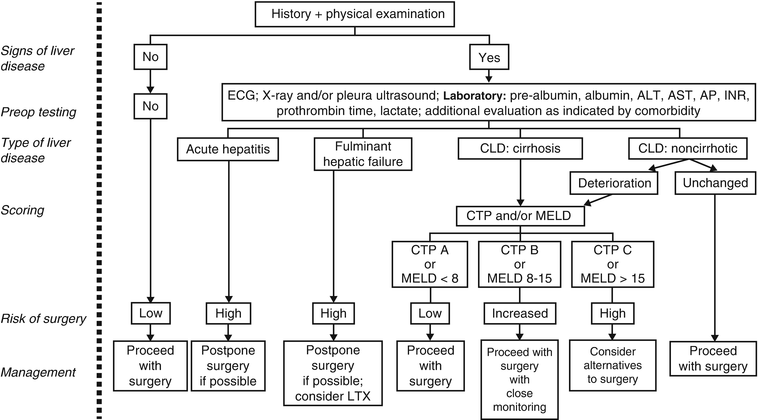Class A
5–6 points
~10 % mortality
Class B
7–9 points
~17–30 % mortality
Class C
10–15 points
~63–82 % mortality
Higher MELD scores generally correlate with worse outcomes [6–10]. For patients with MELD >15, the finding of serum albumin <2.5 has been shown to correlate with worse outcomes [11]. Calculators are widely available online to determine the MELD score. MELD = 3.78 × loge (bilirubin in mg/dl) + 11.2 × loge (INR) + 9.57 × loge (creatinine in mg/dl) + 6.43. Enter 1 for creatinine <1.0 or 4 for creatinine >4 or dialysis. Round to nearest integer. Mortality stratified by MELD score is shown in Table 16.2 [9].
Table 16.2
Postoperative mortality of patients with cirrhosis as predicted by MELD score
MELD | 5 | 10 | 15 | 20 | 25 | 30 | 35 | 40 | 45 | |
|---|---|---|---|---|---|---|---|---|---|---|
Probability of death (%) (95 % CI) | All surgeries | 5 (2 − 13) | 7 (3–15) | 11 (6–19) | 17 (11–25) | 26 (17–38) | 36 (21–53) | 50 (27–73) | 59 (31–82) | 67 (34–89) |
Intra-abdominal surgeries | 5 (1–16) | 8 (3–20) | 14 (7–27) | 25 (15–39) | 35 (21–51) | 58 (34–79) | 75 (43–92) | 83 (48–96) |
The Mayo model (calculator available online) adds ASA classification to MELD score for the prediction of postoperative mortality [10]. It is based on a retrospective study of 772 patients with a median MELD of only 8, however, has not been prospectively validated, and should be applied to diverse populations with caution.
Figure 16.1 shows a risk stratification strategy for both acute hepatitis and chronic liver disease.


Fig. 16.1
Preoperative evaluation and risk stratification in suspected liver disease (reprinted with permission from [16])
Perioperative Management
Preoperative Considerations
Although the internist should refrain from making recommendations about intraoperative care, it is helpful to have some familiarity with issues that may arise during or as a result of anesthesia; these are well detailed elsewhere [12]. Consider making the following recommendations for patients proceeding to surgery:
Delay surgery until after liver transplantation and/or suggest a less invasive option: cholecystostomy in place of cholecystectomy [13], etc.
Preoperative TIPS may reduce perioperative GI bleeding for patients with severe portal hypertension, but at the expense of worsened encephalopathy [14, 15].
Treat ascites with diuretics (if peripheral edema is present), salt restriction, and/or paracentesis.
Evaluate renal function preoperatively, recalling that calculated creatinine clearance may underestimate the degree of impairment.
Stay updated, free articles. Join our Telegram channel

Full access? Get Clinical Tree


